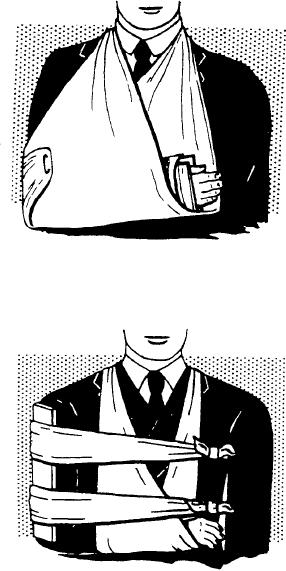
fracture is in the upper part of the arm, in the middle of
the upper arm, or near the elbow.
When the fracture is in the upper part of the arm,
near the shoulder, place a pad or folded towel in the
armpit, bandage the arm securely to the body, and
support the forearm in a narrow sling.
When the fracture is in the middle of the upper arm,
you may use one well-padded splint on the outside of
the arm. The splint should extend from the shoulder to
the elbow. Fasten the splinted arm firmly to the body,
and support the forearm in a narrow sling, as shown in
figure 10-50.
Another method of treating a fracture in the middle
Figure 10-49.--Sling used to support a fractured forearm.
of the upper arm is to fasten two wide splints, or four
narrow ones, around the arm, and support the forearm
in a narrow sling. If you use a splint between the arm
and the body, ensure it does not extend too far up into
the armpit. A splint in this position can cause a
dangerous compression of the blood vessels and nerves
and may be extremely painful to the victim.
When the fracture is at or near the elbow, the arm
may be either bent or straight. No matter what position
you find the arm in, DO NOT ATTEMPT TO
STRAIGHTEN IT OR MOVE IT IN ANY WAY. As
carefully as possible, splint the arm in the position in
which you find it.
Treat the victim for shock and obtain medical care
as soon as possible.
Figure 10-50.--Splint and sling for a fractured upper arm.
FRACTURE OF THE THIGH
The thighbone is the long bone in the upper part of
Put the forearm across the chest. The palm of the
the leg, between the kneecap and the pelvis. When the
hand should be turned in, with the thumb pointing
thighbone is fractured, any attempt to move the limb
upward. Support the forearm in this position by means
results in a spasm of the muscles and causes excruciating
of a wide sling, as shown in figure 10-49. The hand
pain. The leg has a wobbly motion, and there is complete
should be raised about 4 inches above the heel of the
loss of control below the fracture. The limb usually
elbow.
assumes an unnatural position, with the toes pointing
As in all cases of fracture, treat the victim for shock,
outward. The fractured leg is shorter than the uninjured
and obtain medical care as soon as possible.
one, by actual measurement, because of the pull of the
powerful thigh muscles. Serious damage to the blood
FRACTURE OF THE UPPER ARM
vessels and nerves often results from a fracture of the
thighbone. Shock is likely to be severe.
The signs of fracture in the upper arm include pain,
tenderness, swelling, and a wobbly motion at the point
TREATMENT. When the fracture is open, stop the
of fracture. When the fracture is near the elbow, the arm
bleeding and treat the wound before attempting to treat
is likely to be straight, with no bend at the elbow.
the fracture itself. Serious bleeding is a special danger
in this type of injury, since the broken bone may tear or
TREATMENT. When the fracture is open, stop the
cut the large artery in the thigh.
bleeding and treat the wound before attempting to treat
the fracture. Treatment of the fracture depends partly
Carefully straighten the leg. Apply two splints: one
upon the location of the break; that is, whether the
on the outside of the injured leg and one on the inside.
10-35

